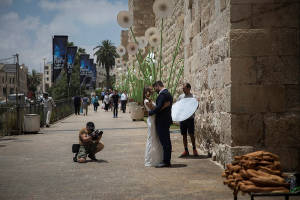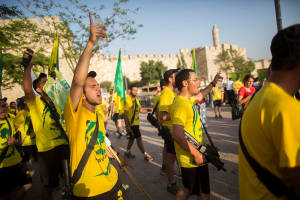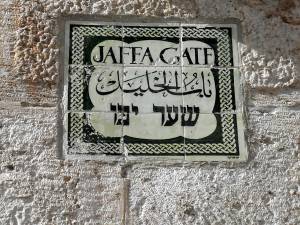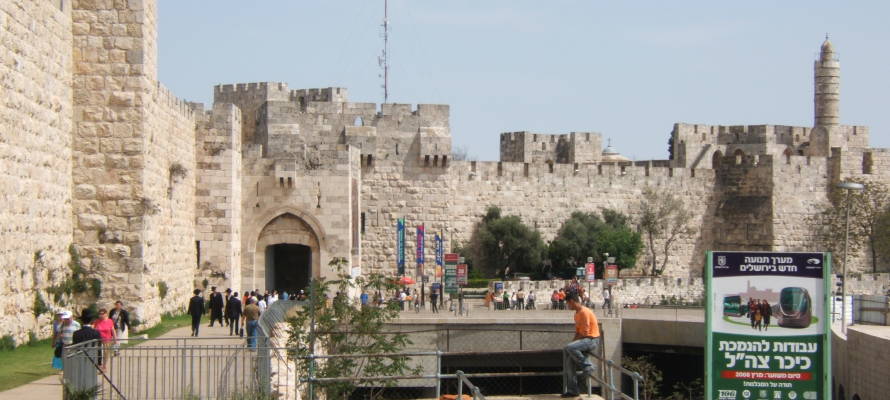In 1967, Israel successfully reunited Jerusalem, the eternal capital of the Jewish people, and once again, Jaffa Gate is in Jewish hands along with the other gates of the Old City.

Since King David first made it his capital about 3000 years ago, the city of Jerusalem has gone through many changes. The size of the city has grown dramatically since David captured the hill called Jebus, or Shalem, from the Jebusites.
King Hezekiah was the first to make a major expansion of Jerusalem when he dramatically extended the city westward to accommodate the refugees from the northern 10 tribes of Israel that were attacked and defeated by the Assyrians at the end of the 8th century BCE, about 300 years after the death of King David.
Up until the year 1860, the borders of the Holy City were defined by what was contained within the walls in the area to now referred to as the Old City of Jerusalem. The Old City is divided into four quarters: Moslem, Christian, Jewish and Armenian. There are eight gates, seven of which are open. Let’s discuss one of the most well-known gates of the Old City, the Jaffa Gate.

An Israeli couple has their wedding pictures taken at Jaffa Gate in Jerusalem’s Old City, on June 11, 2015. (Hadas Parush/Flash90)
The stones used for the Jaffa Gate are large, sand-colored blocks. The entryway is approximately 20 feet high, above which the wall extends about another 20 feet. The gate is built on a right angle seemingly to make it more difficult for invaders as they would have to make a sharp turn as they entered. Located on the right side of the gate as you enter is a mezuzah – a decorative cover containing the words of Deuteronomy 6:4-9 and 11:13-21 handwritten on a parchment with special ink. Jewish law requires a mezuzah to be placed on the doors of every Jewish home as well as private and public gates.
Suleiman the Magnificent built Jaffa Gate, along with Jerusalem’s current walls, in 1538. Jaffa Gate marked the end of the highway that led from the coastal city of Jaffa to Jerusalem, hence the name. It is also known by its Arabic name, Bab el-Halil, or the Gate of the Beloved. The beloved in this case is referring to the patriarch Abraham, who is buried in Hebron. If you leave the gate and head south, you will end up in Hebron. A third name is Bab Mihrab Dauod, the Gate of the Prayer Niche of David, named for King David.

IDF soldiers sing and dance while participating in the Golani Brigade Race at Jaffa Gate on April 28, 2015. (Yonatan Sindel/Flash90)
In celebration of the 25th year of rule of Sultan Abdul Hamid II at the beginning of the 20th century, 100 clock towers were built throughout the Ottoman Empire, six of them in Ottoman-ruled Palestine. One of these six was built on the Jaffa Gate in 1907. It lasted until 1922 when the British knocked it down for aesthetic reasons. It can be seen in early photographs.
Immediately next to Jaffa Gate is a breach in the wall which is used for local traffic into the Old City. There used to be a dry moat there, but it has since been filled in so that the road could be paved as an entrance for vehicular traffic.

(Wikimedia Commons)
On the inside of Jaffa Gate are three signs from three different eras. High up on the gate is a sign from the British Mandate period (1917-1948) saying Jaffa Gate; there is a sign in Arabic identifying the square in front of Jaffa Gate from the Jordanian period (1948-67), and then there is a post-1967 sign identifying the square in Hebrew.
During Israel’s War of Independence in 1948, the Israeli forces tried to connect the Jews who were living in the Old City with western Jerusalem by controlling the Jaffa Gate. Unfortunately they did not succeed. In 1967, during the Six Day War, Israel successfully reunited Jerusalem as the eternal capital of the Jewish people, and once again, Jaffa Gate is in Jewish hands along with the other gates of the Old City.
By: Rabbi Moshe Rothchild, Licensed Tour Guide










